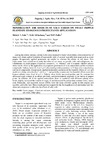MINIMIZATION THE EFFECTS OF SALT STRESS ON SWEET PEPPER PLANTS BY EXOGENOUS PROTECTANTS APPLICATION
| dc.contributor.author | Sakr, MT | |
| dc.contributor.author | El-Sarkassy, NM | |
| dc.contributor.author | Fuller, Michael | |
| dc.date.accessioned | 2016-03-02T10:31:33Z | |
| dc.date.available | 2016-03-02T10:31:33Z | |
| dc.date.issued | 2015-12-01 | |
| dc.identifier.uri | http://hdl.handle.net/10026.1/4370 | |
| dc.description.abstract |
Among the abiotic stresses, salinity is the most destructive factor which limits yield productivity of many crop plants and/or limitation of marketable yield of several vegetable fruit crops such as sweet pepper. Exogenously applied protectants are needed to alleviate the effects of salt stress. Two experiments were carried out to study the effect of salt stress on growth, yield and endogenous bioconstituents on sweet pepper (Capsicum annuum L. cv. Orlando) and to examine whether salinity stress can be offset by the application of exogenous protectants of some antioxidant and bio-stimulant compounds. Salinity stress (2, 4 or 6 g l -1 ) decreased growth parameters at 75 days after transplanting and yield components. Exogenously applied protectants counteracted the harmful effects of low and moderate salinity stress levels (2 and 4 g l -1 ) and partially counteracted the harmful effects under the highest salinity stress level (6 g l -1 ). Salinity stress levels increased proline and Na contents but decreased sugar content, K in shoots and fruits, and photosynthetic pigments in the leaves of pepper plants. In addition, all of the applied antioxidants alone or combined with different salinity stress levels slightly increased the content of sugar, K and decreased Na and proline content. Citric, humic acid, Putrescine, and seaweeds extract (SWE) were the most effective agents in this respect and ascorbic acid is the best. These results provide support for the field application of antioxidant and biostimulant compounds to alleviate the effects of salty soils. | |
| dc.format.extent | 1396-1410 | |
| dc.language | English | |
| dc.language.iso | English | |
| dc.title | MINIMIZATION THE EFFECTS OF SALT STRESS ON SWEET PEPPER PLANTS BY EXOGENOUS PROTECTANTS APPLICATION | |
| dc.type | journal-article | |
| dc.type | Article | |
| plymouth.volume | 42 (6) | |
| plymouth.journal | ZagaZig Journal of Agricultural Botany | |
| plymouth.organisational-group | /Plymouth | |
| plymouth.organisational-group | /Plymouth/Faculty of Science and Engineering | |
| plymouth.organisational-group | /Plymouth/REF 2021 Researchers by UoA | |
| plymouth.organisational-group | /Plymouth/REF 2021 Researchers by UoA/UoA06 Agriculture, Veterinary and Food Science | |
| plymouth.organisational-group | /Plymouth/Users by role | |
| plymouth.organisational-group | /Plymouth/Users by role/Academics | |
| dc.publisher.place | Egypt | |
| dcterms.dateAccepted | 2015-01-01 | |
| dc.rights.embargoperiod | No embargo | |
| rioxxterms.licenseref.uri | http://www.rioxx.net/licenses/all-rights-reserved | |
| rioxxterms.type | Journal Article/Review |


